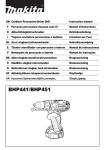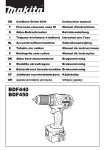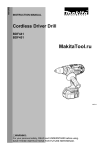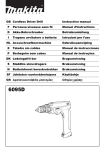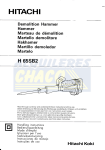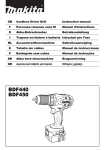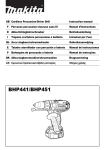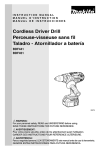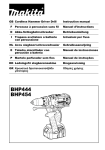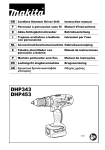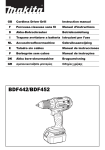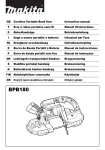Download Makita BDF441 Instruction manual
Transcript
GB Cordless Driver Drill Instruction manual F Perceuse-visseuse sans fil Manuel d’instructions D Akku-Bohrschrauber Betriebsanleitung I Trapano avvitatore a batteria Istruzioni per l’uso NL Accuschroefboormachine Gebruiksaanwijzing E Taladro sin cables Manual de instrucciones P Berbegvim sem cabos Manual de instruções Akku bore-skruemaskine Brugsanvisning S Sladdlös skruvdragare Bruksanvisning N Batteridrevet boreskrutrekker Bruksanvisning SF Johdoton ruuvinväännin/pora Käyttöohje GR Δραπανοκατσάβιδο μπαταρίας DK BDF441/BDF451 Οδηγίες χρήσης 1 2 4 3 1 2 A 5 B 6 3 4 8 7 5 6 12 16 9 13 10 15 14 11 7 2 8 18 17 19 9 10 20 16 21 11 12 23 24 22 13 14 25 26 15 28 27 16 3 29 30 17 4 ENGLISH Explanation of general view 1. 2. 3. 4. 5. 6. 7. 8. 9. 10. Red part Button Battery cartridge Switch trigger Lamp Reversing switch lever Speed change lever Action mode change lever Adjusting ring Graduations 11. 12. 13. 14. 15. 16. 17. 18. 19. 20. Arrow Steel band Grip base Side grip Protrusion Groove Sleeve Bit holder Bit Screw 21. 22. 23. 24. 25. 26. 27. 28. 29. 30. Hook Limit mark Rear cover Screws Arm Spring Recesed part Carbon brush cap Hole Carbon brush cap SPECIFICATIONS Model Capacities No load speed (min-1) BDF441 BDF451 Steel 13 mm 13 mm Wood 50 mm 65 mm Wood screw 6 mm x 75 mm 10 mm x 89 mm Machine screw 6 mm High (2) 0 – 1,700 Medium (2) 0 – 600 Low (1) 0 – 300 Overall length 238 mm Net weight 2.0 kg 2.1 kg Rated voltage D.C. 14.4 V D.C. 18 V • Due to our continuing program of research and development, the specifications herein are subject to change without notice. • Note: Specifications may differ from country to country. Intended use The tool is intended for drilling and screw driving in wood, metal and plastic. SPECIFIC SAFETY RULES DO NOT let comfort or familiarity with product (gained from repeated use) replace strict adherence to drill safety rules. If you use this power tool unsafely or incorrectly, you can suffer serious personal injury. 1. Use auxiliary handles supplied with the tool. Loss of control can cause personal injury. 2. Hold power tools by insulated gripping surfaces when performing an operation where the cutting tool may contact hidden wiring or its own cord. Contact with a “live” wire will make exposed metal parts of the tool “live” and shock the operator. 3. Always be sure you have a firm footing. Be sure no one is below when using the tool in high locations. 4. Hold the tool firmly. 5. Keep hands away from rotating parts. 6. Do not leave the tool running. Operate the tool only when hand-held. 7. Do not touch the drill bit or the workpiece immediately after operation; they may be extremely hot and could burn your skin. 8. Some material contains chemicals which may be toxic. Take caution to prevent dust inhalation and skin contact. Follow material supplier safety data. 5 SAVE THESE INSTRUCTIONS WARNING: MISUSE or failure to follow the safety rules stated in this instruction manual may cause serious personal injury. IMPORTANT SAFETY INSTRUCTIONS FOR BATTERY CARTRIDGE 1. Before using battery cartridge, read all instructions and cautionary markings on (1) battery charger, (2) battery, and (3) product using battery. 2. Do not disassemble battery cartridge. 3. If operating time has become excessively shorter, stop operating immediately. It may result in a risk of overheating, possible burns and even an explosion. 4. If electrolyte gets into your eyes, rinse them out with clear water and seek medical attention right away. It may result in loss of your eyesight. 5. Do not short the battery cartridge: (1) Do not touch the terminals with any conductive material. (2) Avoid storing battery cartridge in a container with other metal objects such as nails, coins, etc. (3) Do not expose battery cartridge to water or rain. A battery short can cause a large current flow, overheating, possible burns and even a breakdown. 6. Do not store the tool and battery cartridge in locations where the temperature may reach or exceed 50°C (122°F). 7. Do not incinerate the battery cartridge even if it is severely damaged or is completely worn out. The battery cartridge can explode in a fire. 8. Be careful not to drop or strike battery. SAVE THESE INSTRUCTIONS Tips for maintaining maximum battery life 1. Charge the battery cartridge before completely discharged. Always stop tool operation and charge the battery cartridge when you notice less tool power. 2. Never recharge a fully charged battery cartridge. Overcharging shortens the battery service life. 3. Charge the battery cartridge with room temperature at 10°C - 40°C (50°F - 104°F). Let a hot battery cartridge cool down before charging it. FUNCTIONAL DESCRIPTION CAUTION: • Always be sure that the tool is switched off and the battery cartridge is removed before adjusting or checking function on the tool. 6 Installing or removing battery cartridge (Fig. 1) • Always switch off the tool before insertion or removal of the battery cartridge. • To remove the battery cartridge, withdraw it from the tool while sliding the button on the side of the cartridge. • To insert the battery cartridge, align the tongue on the battery cartridge with the groove in the housing and slip it into place. Always insert it all the way until it locks in place with a little click. If you can see the red part on the upper side of the button, it is not locked completely. Insert it fully until the red part cannot be seen. If not, it may accidentally fall out of the tool, causing injury to you or someone around you. • Do not use force when inserting the battery cartridge. If the cartridge does not slide in easily, it is not being inserted correctly. Switch action (Fig. 2) CAUTION: • Before inserting the battery cartridge into the tool, always check to see that the switch trigger actuates properly and returns to the “OFF” position when released. To start the tool, simply pull the switch trigger. Tool speed is increased by increasing pressure on the switch trigger. Release the switch trigger to stop. Lighting up the front lamp (Fig. 3) CAUTION: • Do not look in the light or see the source of light directly. Pull the switch trigger to light up the lamp. The lamp keeps on lighting while the switch trigger is being pulled. The lamp goes out 10 -15 seconds after releasing the trigger. NOTE: • Use a dry cloth to wipe the dirt off the lens of lamp. Be careful not to scratch the lens of lamp, or it may lower the illumination. Reversing switch action (Fig. 4) This tool has a reversing switch to change the direction of rotation. Depress the reversing switch lever from the A side for clockwise rotation or from the B side for counterclockwise rotation. When the reversing switch lever is in the neutral position, the switch trigger cannot be pulled. CAUTION: • Always check the direction of rotation before operation. • Use the reversing switch only after the tool comes to a complete stop. Changing the direction of rotation before the tool stops may damage the tool. • When not operating the tool, always set the reversing switch lever to the neutral position. Speed change (Fig. 5) This tool has a three-gear speed change lever. To change the speed, first switch off the tool and then slide the speed change lever to the “1” position for low speed, “2” position for medium speed or “3” position for high speed. Be sure that the speed change lever is set to the correct position before operation. Use the right speed for your job. NOTE: • When changing the position from “1” to “3” or from “3” to “1”, it may be a little difficult to slide the speed change lever. At this time, switch on and run the tool for a second at the “2” position, then stop the tool and slide to your desired position. CAUTION: • Always set the speed change lever fully to the correct position. If you operate the tool with the speed change lever positioned halfway between the “1” position, “2” position and “3” position, the tool may be damaged. • Do not use the speed change lever while the tool is running. The tool may be damaged. Selecting action mode (Fig. 6) This tool has an action mode change lever. For drilling, slide the action mode change lever to the left ( symbol). For screwing, slide the action mode change lever to the right ( symbol). NOTE: • When changing the position from “ ” to “ ”, it may be a little difficult to slide the mode change lever. At this time, switch on and run the tool for a second at the “ ” position, then stop the tool and slide to your desired position. CAUTION: • Always slide the action mode change lever all the way to your desired mode position. If you operate the tool with the lever positioned halfway between the mode symbols, the tool may be damaged. • Do not use the action mode change lever while the tool is running. The tool may be damaged. Adjusting the fastening torque (Fig. 7) The fastening torque can be adjusted in 16 steps by turning the adjusting ring so that its graduations are aligned with the pointer on the tool body. First, slide the action mode change lever to the position of symbol. ASSEMBLY CAUTION: • Always be sure that the tool is switched off and the battery cartridge is removed before carrying out any work on the tool. Installing side grip (auxiliary handle) (Fig. 8) Always use the side grip to ensure operating safety. Insert the side grip so that the protrusions on the grip base fit in between the grooves on the tool barrel. Then tighten the grip by turning clockwise. Installing or removing driver bit or drill bit (Fig. 9) Turn the sleeve counterclockwise to open the chuck jaws. Place the bit in the chuck as far as it will go. Turn the sleeve clockwise to tighten the chuck. To remove the bit, turn the sleeve counterclockwise. Installing bit holder (Fig. 10) Fit the bit holder into the protrusion at the tool foot on either right or left side and secure it with a screw. When not using the driver bit, keep it in the bit holders. Bits 45 mm long can be kept there. Hook (Fig. 11) The hook is convenient for temporarily hanging the tool. This can be installed on either side of the tool. To install the hook, insert it into a groove in the tool housing on either side and then secure it with a screw. To remove, loosen the screw and then take it out. OPERATION (Fig. 12) Screwdriving operation First, slide the action mode change lever to the position of symbol and select the fastening torque. Place the point of the driver bit in the screw head and apply pressure to the tool. Start the tool slowly and then increase the speed gradually. Release the switch trigger as soon as the clutch cuts in. NOTE: • Make sure that the driver bit is inserted straight in the screw head, or the screw and/or bit may be damaged. The fastening torque is minimum when the number 1 is aligned with the pointer, and maximum when the marking is aligned with the pointer. The clutch will slip at various torque levels when set at the number 1 to 16. Before actual operation, drive a trial screw into your material or a piece of duplicate material to determine which torque level is required for a particular application. NOTE: • The adjusting ring does not lock when the pointer is positioned only halfway between the graduations. 7 • When driving wood screws, predrill pilot holes to make driving easier and to prevent splitting of the workpiece. See the chart. Nominal diameter of wood Recommended size of pilot screw (mm) hole (mm) 3.1 2.0 - 2.2 3.5 2.2 - 2.5 3.8 2.5 - 2.8 4.5 2.9 - 3.2 4.8 3.1 - 3.4 5.1 3.3 - 3.6 5.5 3.7 - 3.9 5.8 4.0 - 4.2 6.1 4.2 - 4.4 • If the tool is operated continuously until the battery cartridge has discharged, allow the tool to rest for 15 minutes before proceeding with a fresh battery. Drilling operation First, slide the action mode change lever to the position of symbol. Drilling in wood When drilling in wood, the best results are obtained with wood drills equipped with a guide screw. The guide screw makes drilling easier by pulling the bit into the workpiece. Drilling in metal To prevent the bit from slipping when starting a hole, make an indentation with a center-punch and hammer at the point to be drilled. Place the point of the bit in the indentation and start drilling. Use a cutting lubricant when drilling metals. The exceptions are iron and brass which should be drilled dry. CAUTION: • Pressing excessively on the tool will not speed up the drilling. In fact, this excessive pressure will only serve to damage the tip of your bit, decrease the tool performance and shorten the service life of the tool. • There is a tremendous force exerted on the tool/bit at the time of hole break through. Hold the tool firmly and exert care when the bit begins to break through the workpiece. • A stuck bit can be removed simply by setting the reversing switch to reverse rotation in order to back out. However, the tool may back out abruptly if you do not hold it firmly. • Always secure small workpieces in a vise or similar hold-down device. • If the tool is operated continuously until the battery cartridge has discharged, allow the tool to rest for 15 minutes before proceeding with a fresh battery. 8 MAINTENANCE CAUTION: • Always be sure that the tool is switched off and the battery cartridge is removed before attempting to perform inspection or maintenance. Replacing carbon brushes Replace when they wear down to the limit mark. Keep the carbon brushes clean and free to slip in the holders. Both carbon brushes should be replaced at the same time. Use only identical carbon brushes. (Fig. 13) Use a screwdriver to remove two screws then remove the rear cover. (Fig. 14) Raise the arm part of the spring and then place it in the recessed part of the housing with a slotted bit screwdriver of slender shaft or the like. (Fig. 15) Use pliers to remove the carbonbrush caps of the carbon brushes. Take out the worn carbon brushes, insert the new ones and replace the carbonbrush caps in reverse. (Fig. 16) Make sure that the carbonbrush caps have fit into the holes in brush holders securely. (Fig. 17) Reinstall the rear cover and tighten two screws securely. To maintain product SAFETY and RELIABILITY, repairs, any other maintenance or adjustment should be performed by Makita Authorized Service Centers, always using Makita replacement parts. ACCESSORIES CAUTION: • These accessories or attachments are recommended for use with your Makita tool specified in this manual. The use of any other accessories or attachments might present a risk of injury to persons. Only use accessory or attachment for its stated purpose. If you need any assistance for more details regarding these accessories, ask your local Makita service center. • • • • • • • • Drill bits Screw bits Hook Grip assembly Various type of Makita genuine batteries and chargers Rubber pad assembly Wool bonnet Foam polishing pad NEDERLANDS Verklaring van het onderdelenoverzicht 1. 2. 3. 4. 5. 6. 7. 8. 9. 10. Rode deel Knop Accu Aan/uit-schakelaar Lamp Omkeerschakelaar Snelheidsinstelknop Werkingsfunctie-instelknop Instelring Schaalverdeling 11. 12. 13. 14. 15. 16. 17. 18. 19. 20. Pijlpunt Metalen klemband Basis van de zijhandgreep Zijhandgreep Uitsteeksel Groef Mof Bithouder Bit Schroef 21. 22. 23. 24. 25. 26. 27. 28. 29. 30. Haak Slijtgrensmarkering Achterkap Schroeven Arm Veer Verdiept gedeelte Koolborstelkap Opening Koolborstelkap TECHNISCHE GEGEVENS Model Capaciteiten BDF441 BDF451 Metaal 13 mm 13 mm Hout 50 mm 65 mm Houtschroef 6 mm x 75 mm 10 mm x 89 mm Machineschroef 6 mm Hoog (3) 0 – 1700 Onbelaste snelheid (min-1) Normaal (2) 0 – 600 Laag (1) 0 – 300 Totale lengte 238 mm Netto gewicht 2,0 kg 2,1 kg Nominale spanning 14,4 V gelijkstroom 18 V gelijkstroom • Als gevolg van ons doorlopende onderzoeks- en ontwikkelingsprogramma, zijn de technische gegevens van dit gereedschap onderhevig aan veranderingen zonder voorafgaande kennisgeving. • Opmerking: De technische gegevens kunnen van land tot land verschillen. Gebruiksdoeleinden Het gereedschap is bedoeld voor boren en schroeven in hout, metaal en kunststof. AANVULLENDE VEILIGHEIDSVOORSCHRIFTEN Laat u NIET misleiden door een vals gevoel van comfort en bekendheid met het gereedschap (na veelvuldig gebruik) en neem alle veiligheidsvoorschriften van de schroefboormachine altijd strikt in acht. Bij onveilig of verkeerd gebruik van het elektrisch gereedschap, bestaat de kans op ernstig persoonlijk letsel. 1. Gebruik de hulphandgrepen die bij het gereedschap werden geleverd. Als u de controle over het gereedschap verliest, kan dit leiden tot ernstig persoonlijk letsel. 2. Houd elektrisch gereedschap vast aan het geïsoleerde oppervlak van de handgrepen wanneer u werkt op plaatsen waar het zaaggereedschap met verborgen bedrading of zijn eigen snoer in aanraking kan komen. Door contact met onder spanning staande draden, zullen de nietgeïsoleerde metalen delen van het gereedschap onder spanning komen te staan zodat de gebruiker een elektrische schok kan krijgen. 3. Zorg er altijd voor dat u stevig staat. Zorg ervoor dat er niemand zich onder u bevindt wanneer u het gereedschap op een hoge plaats gebruikt. 4. Houd het gereedschap stevig vast. 24 5. Houd uw handen uit de buurt van draaiende delen. 6. Laat het gereedschap niet ingeschakeld liggen. Bedien het gereedschap alleen wanneer u het vasthoudt. 7. Raak het schroef- of boorbit en het werkstuk niet onmiddellijk na gebruik aan. Zij kunnen bijzonder heet zijn en brandwonden op uw huid veroorzaken. 8. Sommige materialen bevatten chemische stoffen die giftig kunnen zijn. Neem voorzorgsmaatregelen tegen het inademen van stof en contact met de huid. Volg de veiligheidsinstructies van de leverancier van het materiaal op. BEWAAR DEZE VOORSCHRIFTEN WAARSCHUWING: VERKEERD GEBRUIK of het niet volgen van de veiligheidsinstructies in deze gebruiksaanwijzing kan leiden tot ernstig persoonlijk letsel. BELANGRIJKE VEILIGHEIDSINSTRUCTIES VOOR ACCU’S 1. Alvorens de accu in gebruik te nemen, leest u eerst alle instructies en waarschuwingsopschriften op (1) de acculader, (2) de accu en (3) het apparaat waarin de accu wordt aangebracht. 2. Haal de accu niet uit elkaar. 3. Als de gebruikstijd aanzienlijk korter is geworden, stopt u onmiddellijk met het gebruik. Anders kan dit leiden tot kans op oververhitting, mogelijke brandwonden en zelfs een explosie. 4. Als de elektrolyt in uw ogen komt, wast u deze uit met schoon water en raadpleegt u onmiddellijk een arts. Dit kan leiden tot verlies van gezichtsvermogen. 5. Sluit de accu niet kort: (1) Raak de accupolen niet aan met enig geleidend materiaal. (2) Bewaar de accu niet op een plaats waar deze in aanraking kan komen met andere metalen voorwerpen, zoals spijkers, munten, enz. (3) Stel de accu niet bloot aan water of regen. Kortsluiting van de accu kan leiden tot een hoge stroomsterke, oververhitting, mogelijke brandwonden en zelfs een defect. 6. Bewaar het gereedschap en de accu niet op plaatsen waar de temperatuur kan oplopen tot 50 °C of hoger. 7. Werp de accu niet in een vuur, zelfs niet als deze al ernstig beschadigd of helemaal versleten is. De accu kan in een vuur exploderen. 8. Wees voorzichtig dat u de accu niet laat vallen of ergens tegenaan stoot. BEWAAR DEZE VOORSCHRIFTEN Tips voor een lange levensduur van de accu 1. Laad de accu op voordat deze volledig leeg is. Wanneer u merkt dat het gereedschap minder vermogen heeft, stopt u met het gebruik ervan en laadt u eerst de accu op. 2. Laad nooit een volledig opgeladen accu op. Te lang opladen verkort de levensduur van de accu. 3. Laad de accu op bij een omgevingstemperatuur van 10 °C t/m 40 °C. Laat een warme accu eerst afkoelen voordat u deze oplaadt. BESCHRIJVING VAN DE FUNCTIES LET OP: • Controleer altijd of het gereedschap is uitgeschakeld en de accu is verwijderd alvorens de functies van het gereedschap te controleren of af te stellen. De accu aanbrengen en verwijderen (zie afb. 1) • Schakel het gereedschap altijd uit voordat u de accu aanbrengt of verwijdert. • Om de accu te verwijderen verschuift u de knop aan de zijkant van de accu en trekt u tegelijkertijd de accu uit het gereedschap. • Om de accu aan te brengen lijnt u de lip op de accu uit met de groef in de behuizing en duwt u de accu op zijn plaats. Steek de accu zo ver mogelijk in het gereedschap tot u een klikgeluid hoort. Als u het rode deel aan de bovenkant van de knop kunt zien, is de accu niet goed aangebracht. Steek de accu zo ver mogelijk erin tot het rode deel niet meer zichtbaar is. Als u dit niet doet, kan de accu per ongeluk uit het gereedschap vallen en u of anderen in uw omgeving verwonden. • Oefen geen grote kracht uit bij het aanbrengen van de accu. Als de accu niet gemakkelijk in het gereedschap kan worden gestoken, wordt deze niet goed aangebracht. Aan/uit-schakelaar (zie afb. 2) LET OP: • Controleer altijd, voordat u de accu in het gereedschap steekt, of de aan/uit-schakelaar op de juiste manier schakelt en weer terugkeert naar de uit-stand nadat deze is losgelaten. Om het gereedschap in te schakelen, knijpt u gewoon de aan/uit-schakelaar in. De draaisnelheid van het gereedschap neemt toe naarmate u meer druk uitoefent op de aan/uit-schakelaar. Laat de aan/uit-schakelaar los om het gereedschap te stoppen 25 De lamp op de voorkant inschakelen (zie afb. 3) LET OP: • Kijk niet rechtstreeks in het licht of naar de bron van de lamp. Knijp de aan/uit-schakelaar in om de lamp op de voorkant in te schakelen. De lamp blijft branden zolang u de aan/ uit-schakelaar ingeknepen houdt. De lamp gaat 10 tot 15 seconden nadat u de aan/uit-schakelaar hebt losgelaten uit. OPMERKING: • Gebruik een doek om het vuil van de lens van de lamp te vegen. Wees voorzichtig de lens van de lamp niet te bekrassen om de lichtopbrengst niet te verlagen. Werking van de omkeerschakelaar (zie afb. 4) Dit gereedschap is uitgerust met een omkeerschakelaar waarmee u de draairichting kunt omkeren. Druk op de omkeerschakelaar vanaf kant A voor de draairichting rechtsom, of vanaf kant B voor de draairichting linksom. Wanneer de omkeerschakelaar in de middenstand staat, kunt u de aan/uit-schakelaar niet inknijpen. LET OP: • Controleer altijd de draairichting alvorens het gereedschap te gebruiken. • Gebruik de omkeerschakelaar alleen nadat het gereedschap volledig tot stilstand is gekomen. Als u de draairichting verandert voordat het gereedschap volledig stilstaat, kan het gereedschap worden beschadigd. • Als u het gereedschap niet gebruikt, zet u de omkeerschakelaar altijd in de middenstand. De draaisnelheid veranderen (zie afb. 5) Dit gereedschap is uitgerust met een driestands snelheidsinstelknop. Om de draaisnelheid van het gereedschap te veranderen, schakelt u eerst het gereedschap uit en verschuift u daarna de snelheidsinstelknop naar stand “1” voor een lage draaisnelheid, naar stand “2” voor een normale draaisnelheid, of naar stand “3” voor een hoge draaisnelheid. Zorg ervoor dat de snelheidsinstelknop in de juiste stand staat alvorens het gereedschap te bedienen. Gebruik de juiste draaisnelheid voor uw klus. OPMERKING: • Wanneer u de stand verandert van “1” naar “3” of van “3” naar “1”, kan het een enigszins moeilijk zijn de snelheidsinstelknop te verschuiven. Als dat het geval is, verschuift u de snelheidsinstelknop naar stand “2” en schakelt u het gereedschap eventjes in. Schakel vervolgens het gereedschap uit en verschuif de snelheidsinstelknop naar de gewenste stand. LET OP: • Zet de snelheidsinstelknop altijd volledig in de gewenste stand. Als u het gereedschap bedient terwijl de snelheidsinstelknop halverwege de standen “1” en 26 “2”, of “2” en “3” staat, kan het gereedschap worden beschadigd. • Bedien de snelheidsinstelknop niet terwijl het gereedschap draait. Het gereedschap kan hierdoor worden beschadigd. De werkingsfunctie kiezen (zie afb. 6) Dit gereedschap heeft een werkingsfunctie-instelknop. Verschuif de werkingsfunctie-instelknop naar links voor boren (symbool ). Verschuif de werkingsfunctieinstelknop naar rechts voor schroeven (symbool ). OPMERKING: • Wanneer u de stand verandert van “ ” naar “ ”, kan het een enigszins moeilijk zijn de werkingsfunctieinstelknop te verschuiven. Als dat het geval is, verschuift u de werkingsfunctie-instelknop naar de stand “ ” en schakelt u het gereedschap eventjes in. Schakel vervolgens het gereedschap uit en verschuif de werkingsfunctie-instelknop naar de gewenste stand. LET OP: • Verschuif de werkingsfunctie-instelknop altijd helemaal naar de gewenste stand. Als u het gereedschap bedient met de instelknop ingesteld tussen de twee werkingsfunctiesymbolen in, kan het gereedschap worden beschadigd. • Bedien de werkingsfunctie-instelknop niet terwijl het gereedschap draait. Het gereedschap kan hierdoor worden beschadigd. Het draaikoppel instellen (zie afb. 7) Het draaikoppel kan in 16 stappen worden ingesteld door de instelring te draaien zodat de gewenste stand op de schaalverdeling is uitgelijnd met de aanwijspunt op de behuizing van het gereedschap. Verschuif eerst de werkingsfunctie-instelknop naar de stand met het symbool . Het draaikoppel is minimaal wanneer stand 1 is uitgelijnd met de aanwijspunt, en maximaal wanneer het symbool is uitgelijnd met de aanwijspunt. In de standen 1 t/m 16 zal de koppeling slippen bij steeds oplopende draaikoppelniveaus. Bepaal het juiste draaikoppelniveau door bij wijze van proef een schroef in het materiaal of een stuk gelijkwaardig materiaal te draaien, alvorens het gereedschap voor de daadwerkelijke klus te gebruiken. OPMERKING: • De instelring wordt niet vergrendeld wanneer de pijlpunt halverwege tussen twee standen staat. ONDERDELEN AANBRENGEN/ VERWIJDEREN LET OP: • Controleer altijd of het gereedschap is uitgeschakeld en de accu is verwijderd alvorens enige werkzaamheden aan het gereedschap te verrichten. De zijhandgreep monteren (extra handgreep) (zie afb. 8) vergemakkelijken en te voorkomen dat het werkstuk splijt. Zie de tabel. Gebruik altijd de zijhandgreep om veilig te kunnen werken. Nominale diameter van houtschroef (mm) Plaats de stalen klemband van de zijhandgreep zodanig over de kop van het gereedschap dat de uitsteeksels op de basis van de zijhandgreep in de groeven van het gereedschap passen. Draai daarna de zijhandgreep vast door deze rechtsom te draaien. Het schroefbit of boorbit aanbrengen en verwijderen (zie afb. 9) Draai de mof linksom om de klauwen in de spankop te openen. Steek het bit zo ver mogelijk in de spankop. Draai de mof rechtsom om de spankop te sluiten. Om het bit te verwijderen, draait u de mof linksom. De bithouder aanbrengen (zie afb. 10) Pas de bithouder in de uitsparingen op de linker- of rechterzijkant van de voet van het gereedschap en zet deze vast met een schroef. Wanneer u een bit niet gebruikt, klemt u deze in de bithouder. U kunt hierin bits van 45 mm lengte bewaren. Haak (zie afb. 11) De haak is handig om het gereedschap tijdelijk aan op te hangen. De haak kan aan beide kanten van het gereedschap worden bevestigd. U bevestigt de haak door deze in een groef in de behuizing van het gereedschap te steken en vast te zetten met een schroef. Om de haak te verwijderen, draait u de schroef los en haalt u de haak van het gereedschap af. BEDIENING (zie afb. 12) Gebruik als schroevendraaier Verschuif eerst de werkingsfunctie-instelknop naar de stand met het symbool en stel het draaikoppel in. Plaats de punt van het schroefbit in de schroefkop en oefen druk uit op het gereedschap. Start het gereedschap op lage snelheid en voer vervolgens de snelheid geleidelijk op. Laat de aan/uit-schakelaar los zodra de koppeling begint te slippen. OPMERKING: • Zorg ervoor dat het schroefbit recht op de schroefkop staat omdat anders de schroef en/of het bit kunnen worden beschadigd. • Bij het schroeven van houtschroeven moet u de boorgaten voorboren om het schroeven te Aanbevolen diameter voorgeboord gat (mm) 3,1 2,0 - 2,2 3,5 2,2 - 2,5 3,8 2,5 - 2,8 4,5 2,9 - 3,2 4,8 3,1 - 3,4 5,1 3,3 - 3,6 5,5 3,7 - 3,9 5,8 4,0 - 4,2 6,1 4,2 - 4,4 • Als het gereedschap continu wordt bediend totdat de accu leeg is, laat u het gereedschap gedurende 15 minuten liggen alvorens verder te werken met een volle accu. Gebruik als boor Verschuif eerst de werkingsfunctie-instelknop naar de stand met het symbool . Boren in hout Bij het boren in hout verkrijgt u de beste resultaten met houtboren voorzien van een geleideschroef. De geleideschroef zorgt ervoor dat het boren gemakkelijker verloopt door het bit in het werkstuk te trekken. Boren in metaal Om te voorkomen dat bij het beginnen van het boren het bit wegglijdt, maakt u een putje met een centerpons en hamer op het punt waar u wilt boren. Plaats de punt van het bit in het putje en begin te boren. Gebruik bij het boren in metaal een snijolie als smeermiddel. De uitzonderingen hierop zijn ijzer en messing, die droog moeten worden geboord. LET OP: • Het boren zal niet sneller verlopen als u hard op het gereedschap drukt. In feite zal dergelijk duwen alleen maar leiden tot beschadiging van het bit, verlagen van de prestaties van het gereedschap, en verkorten van de levensduur van het gereedschap. • Op het moment dat het boorgat doorbreekt wordt een enorme kracht uitgeoefend op het gereedschap/bit. Houd het gereedschap stevig vast en let goed op wanneer het bit door het werkstuk breekt. • Een vastgelopen bit kan eenvoudigweg worden verwijderd door de omkeerschakelaar in de stand voor achteruitdraaien te zetten om het bit te verwijderen. Het gereedschap kan echter plotseling achteruit komen als u het niet stevig vasthoudt. • Zet kleine werkstukken altijd vast in een bankschroef of soortgelijk bevestigingsmiddel. • Als het gereedschap continu wordt bediend totdat de accu leeg is, laat u het gereedschap gedurende 15 minuten liggen alvorens verder te werken met een volle accu. 27 ONDERHOUD LET OP: • Zorg er altijd voor dat de machine is uitgeschakeld en de accu is verwijderd, voordat u een inspectie of onderhoud uitvoert. De koolborstels vervangen Vervang deze wanneer ze tot aan de slijtgrensmarkering zijn afgesleten. Houd de koolborstels schoon en zorg ervoor dat ze vrij kunnen bewegen in de houders. Beide koolborstels dienen tegelijkertijd te worden vervangen. Gebruik alleen identieke koolborstels (zie afb. 13). Verwijder met behulp van een schroevendraaier de twee schroeven en vervolgens de achterkap (zie afb. 14). Til de arm van de veer op en plaats deze vervolgens in het verdiepte deel van de behuizing met behulp van een platkopschroevendraaier, een dunne steel, of iets dergelijks (zie afb. 15). Verwijder de koolborstelkap van de koolborstels met behulp van een tang. Haal de versleten koolborstels eruit, plaats de nieuwe erin, en plaats de koolborstelkappen in omgekeerde volgorde terug (zie afb. 16). Zorg ervoor dat iedere koolborstelkap goed in de opening in de borstelhouder valt (zie afb. 17). Plaats de achterkap terug en draai de twee schroeven stevig aan. Om de VEILIGHEID en BETROUWBAARHEID van het gereedschap te handhaven, dienen alle reparaties, onderhoud en afstellingen te worden uitgevoerd door een erkend Makita-servicecentrum, en altijd met gebruikmaking van originele Makitavervangingsonderdelen. ACCESSOIRES LET OP: • Deze accessoires of hulpstukken worden aanbevolen voor gebruik met het Makita-gereedschap dat in deze gebruiksaanwijzing wordt beschreven. Het gebruik van andere accessoires of hulpstukken kan gevaar voor persoonlijk letsel opleveren. Gebruik de accessoires of hulpstukken uitsluitend voor de aangegeven gebruiksdoeleinden. Mocht u meer informatie willen hebben over deze accessoires, dan kunt u contact opnemen met uw plaatselijke Makita-servicecentrum. • • • • • • • • 28 Boorbits Schroefbits Haak Zijhandgreep, compleet Diverse types originele Makita-accu’s en acculaders Rubberen accessoire Wollen accessoire Schuimrubberen polijstaccessoire ENGLISH ITALIANO EC-DECLARATION OF CONFORMITY We declare under our sole responsibility that this product is in compliance with the following standards of standardized documents, EN60745, EN55014 in accordance with Council Directives, 89/336/EEC, 98/37/EC. LE NORME DELLA COMUNITÀ EUROPEA Dichiariamo sotto la nostra sola responsabilità che questo prodotto è conforme agli standard di documenti standardizzati seguenti: EN60745, EN55014 secondo le direttive del Consiglio 89/336/CEE e 98/37/CE. FRANÇAIS NEDERLANDS DÉCLARATION DE CONFORMITÉ CE Nous déclarons sous notre entière responsabilité que ce produit est conforme aux normes des documents standardisés suivants, EN60745, EN55014, conformément aux Directives du Conseil, 89/336/CEE et 98/37/EG. EG-VERKLARING VAN CONFORMITEIT Wij verklaren hierbij uitsluitend op eigen verantwoordelijkheid dat dit produkt voldoet aan de volgende normen van genormaliseerde documenten, EN60745, EN55014 in overeenstemming met de richtlijnen van de Raad 89/336/EEC en 98/37/EC. DEUTSCH ESPAÑOL CE-KONFORMITÄTSERKLÄRUNG Hiermit erklärt wir unter unserer alleinigen Verantwortung, daß dieses Produkt gemäß den Ratsdirektiven 89/336/EWG und 98/37/EG mit den folgenden Normen von Normendokumenten übereinstimmen: EN60745, EN55014 DECLARACIÓN DE CONFORMIDAD DE LA CE Declaramos bajo nuestra sola responsabilidad que este producto cumple con las siguientes normas de documentos normalizados, EN60745, EN55014 de acuerdo con las directivas comunitarias, 89/336/EEC y 98/37/CE. Yasuhiko Kanzaki CE 2005 Director Directeur Direktor Amministratore Directeur Director MAKITA INTERNATIONAL EUROPE LTD. Michigan Drive, Tongwell, Milton Keynes, Bucks MK15 8JD, ENGLAND Responsible manufacturer: Fabricant responsable : Verantwortlicher Hersteller: Produttore responsabile: Verantwoordelijke fabrikant: Fabricante responsable: Makita Corporation Anjo Aichi Japan 60 PORTUGUÊS NORSK DECLARAÇÃO DE CONFORMIDADE DA CE Declaramos sob inteira responsabilidade que este produto obedece às seguintes normas de documentos normalizados, EN60745, EN55014 de acordo com as directivas 89/336/CEE e 98/37/CE do Conselho. EUs SAMSVARS-ERKLÆRING Vi erklærer på eget ansvar at dette produktet er i overensstemmelse med følgende standard i de standardiserte dokumenter: EN60745, EN550140, i samsvar med Råds-direktivene, 89/336/EEC og 98/37/EC. DANSK SUOMI EU-DEKLARATION OM KONFORMITET Vi erklærer hermed på eget ansvar, at dette produkt er i overensstemmelse med de følgende standarder i de normsættende dokumenter, EN60745, EN55014 i overensstemmelse med Rådets Direktiver, 89/336/EEC og 98/37/EC. VAKUUTUS EC-VASTAAVUUDESTA Yksinomaisesti vastuullisina ilmoitamme, että tämä tuote on seuraavien standardoitujen dokumenttien standardien mukainen, EN60745, EN55014 neuvoston direktiivien 89/336/EEC ja 98/37/EC mukaisesti. SVENSKA ΕΛΛΗΝΙΚΑ EG-DEKLARATION OM ÖVERENSSTÄMMELSE Under eget ansvar deklarerar vi härmed att denna produkt överensstämmer med följande standardiseringar för standardiserade dokument, EN60745, EN55014 i enlighet med EG-direktiven 89/336/EEC och 98/37/EC. ΔΗΛΩΣΗ ΣΥΜΜΟΡΦΩΣΗΣ ΕΚ Δηλώνουμε υπ την μοναδική μας ευθύνη τι αυτ το προϊν βρίσκεται σε Συμφωνία με τα ακλουθα πρτυπα τυποποιημένων εγγράφων, EN60745, EN55014 σύμφωνα με τις Οδηγίες του Συμβουλίου, 89/336/EEC και 98/37/EC. Yasuhiko Kanzaki CE 2005 Director Direktør Direktör Direktor Johtaja Διευθυντής MAKITA INTERNATIONAL EUROPE LTD. Michigan Drive, Tongwell, Milton Keynes, Bucks MK15 8JD, ENGLAND Fabricante responsável: Ansvarlig fabrikant: Ansvarig tillverkare: Ansvarlig produsent: Vastaava valmistaja: Yπεύθυνος κατασκευαστής: Makita Corporation Anjo Aichi Japan 61 ENGLISH ITALIANO For Model BDF441 For European countries only Noise and Vibration The typical A-weighted sound pressure level is 72 dB (A). Uncertainty is 3 dB(A). The noise level under working may exceed 85 dB (A). - Wear ear protection. The typical weighted root mean square acceleration value is not more than 2.5 m/s2. These values have been obtained according to EN60745. Modello BDF441 Solo per i paesi europei Rumore e vibrazione Il livello tipico di pressione sonora ponderato A è di 72 dB (A). Eventuali variazioni sono comprese in 3 dB (A). Il livello acustico in funzionamento può superare 85 dB (A). - Indossare una protezione acustica. In genere, il valore efficace ponderato dell'accelerazione non supera i 2,5 m/s2. Questi valori sono stati ottenuti in conformità con la norma EN60745. FRANÇAIS NEDERLANDS Pour le modèle BDF441 Pour l’Europe uniquement Bruit et vibration Le niveau de pression sonore pondérée A typique est 72 dB (A). L’incertitude est de 3 dB (A). Le niveau de bruit peut dépasser 85 dB (A) lors de l’utilisation. - Portez des protections d’oreilles. La valeur d’accélération quadratique pondérée typique ne dépasse pas 2,5 m/s2. Ces valeurs ont été obtenues selon EN60745. Voor model BDF441 Alleen voor Europese landen Geluid en trillingen Het typische, A-gewogen geluidsdrukniveau is 72 dB (A). De afwijking is 3 dB (A). Het geluidsniveau kan tijdens gebruik hoger worden dan 85 dB (A). - Draag gehoorbescherming. De typisch, gewogen, kwadratisch-gemiddelde versnellingswaarde is niet hoger dan 2,5 m/s2. Deze waarden zijn verkregen volgens EN60745. DEUTSCH ESPAÑOL Für das Modell BDF441 Nur für europäische Länder Geräusche und Vibrationen Der typische Schalldruck beträgt 72 dB (A). Die Abweichung beträgt 3 dB (A). Unter Arbeitsbedingungen kann der Schalldruck 85 dB (A) überschreiten. – Tragen Sie einen Gehörschutz. Der typische effektive Beschleunigungswert beträgt höchstens 2,5 m/s2. Diese Werte wurden entsprechend der Norm EN60745 gewonnen Para el modelo BDF441 Sólo para los países europeos Ruido y vibración El nivel de presión acústica típico ponderado A es de 72 dB (A). La incertidumbre es de 3 dB (A). El nivel de ruido durante el trabajo puede superar los 85 dB (A). - Utilice protección para los oídos. El valor ponderado de aceleración no es superior a 2,5 m/s2. Estos valores se han obtenido conforme a EN60745. Yasuhiko Kanzaki CE 2005 Director Directeur Direktor Amministratore Directeur Director MAKITA INTERNATIONAL EUROPE LTD. Michigan Drive, Tongwell, Milton Keynes, Bucks MK15 8JD, ENGLAND Responsible manufacturer: Fabricant responsable : Verantwortlicher Hersteller: Produttore responsabile: Verantwoordelijke fabrikant: Fabricante responsable: Makita Corporation Anjo Aichi Japan 62 PORTUGUÊS NORSK Para o Modelo BDF441 Apenas para os países Europeus Ruído e vibrações O nível acústico ponderado A é de 72 dB (A). O coeficiente de imprecisão é de 3 dB (A). O nível de ruído quando em funcionamento pode exceder os 85 dB (A). - Use protecção para os ouvidos. A raiz quadrada do valor médio ponderado da variação da aceleração não é superior a 2,5 m/s2. Estes valores foram obtidos segundo a norma EN60745. For modell BDF441 Gjelder bare land i Europa Støy og vibrasjoner Typisk A-vektet lydtrykknivå er 72 dB (A). Usikkerheten er på 3 dB(A). Støynivået under arbeid kan overskride 85 dB (A). - Bruk hørselvern. Typisk vektet kvadratisk middelverdi av akselerasjonen er ikke mer enn 2,5 m/s2. Disse verdiene er fremkommet i samsvar med EN60745. DANSK SUOMI For Model BDF441 Kun for lande i Europa Støj og Vibration Det typiske A-vægtede lydtryksniveau er 72 dB (A). Usikkerheden er 3 dB (A). Støjniveauet under arbejdet kan være større end 85 dB (A). - Bær høreværn. Den typiske vægtede effektive accelerationsværdi er ikke over 2,5 m/s2. Disse værdier er målt i overensstemmelse med EN60745. Malli BDF441 Vain Euroopan maat Melu ja värinä Tyypillinen A-painotettu äänenpainetaso on 72 dB (A). Virhemarginaali 3 dB (A). Työskentelyn aikana melutaso voi ylittää 85 dB (A). - Käytä kuulosuojaimia. Tyypillinen painotettu tehollisarvo on enintään 2,5 m/s2. Nämä arvot on saatu standardin EN60745 mukaisesti. SVENSKA ΕΛΛΗΝΙΚΑ För modell BDF441 Endast för länder i Europa Buller och vibrationer Normal ljudtrycksnivå är 72 dB (A). Mättoleransen är 3 dB (A). Bullernivån under drift kan överstiga 85 dB (A). - Använd hörselskydd. Kvadratiska medelvärdet för accelerationen är inte mer än 2,5 m/s2. Dessa värden är framtagna i enlighet med EN60745. Για το μοντέλο BDF441 Για ευρωπαϊκές χώρες μ!νο Θ!ρυβος και κραδασμ!ς Το σύνηθες σταθμισμένο επίπεδο ηχητικής πίεσης είναι 72 dB (A). Η αβεβαιτητα είναι 3 dB (A). Το επίπεδο θορύβου σε λειτουργία ενδέχεται να υπερβεί τα 85 dB (A). - Να φοράτε ωτοασπίδες. Η συνήθης σταθμισμένη μέση τετραγωνική ρίζα της τιμής επιτάχυνσης δεν υπερβαίνει τα 2,5 m/s2. Οι τιμές αυτές έχουν ληφθεί σύμφωνα με το EN60745. Yasuhiko Kanzaki CE 2005 Director Direktør Direktör Direktor Johtaja Διευθυντής MAKITA INTERNATIONAL EUROPE LTD. Michigan Drive, Tongwell, Milton Keynes, Bucks MK15 8JD, ENGLAND Fabricante responsável: Ansvarlig fabrikant: Ansvarig tillverkare: Ansvarlig produsent: Vastaava valmistaja: Yπεύθυνος κατασκευαστής: Makita Corporation Anjo Aichi Japan 63 ENGLISH ITALIANO For Model BDF451 For European countries only Noise and Vibration The typical A-weighted sound pressure level is 71 dB (A). Uncertainty is 3 dB(A). The noise level under working may exceed 85 dB (A). - Wear ear protection. The typical weighted root mean square acceleration value is not more than 2.5 m/s2. These values have been obtained according to EN60745. Modello BDF451 Solo per i paesi europei Rumore e vibrazione Il livello tipico di pressione sonora ponderato A è di 71 dB (A). Eventuali variazioni sono comprese in 3 dB (A). Il livello acustico in funzionamento può superare 85 dB (A). - Indossare una protezione acustica. In genere, il valore efficace ponderato dell'accelerazione non supera i 2,5 m/s2. Questi valori sono stati ottenuti in conformità con la norma EN60745. FRANÇAIS NEDERLANDS Pour le modèle BDF451 Pour l’Europe uniquement Bruit et vibration Le niveau de pression sonore pondérée A typique est 71 dB (A). L’incertitude est de 3 dB (A). Le niveau de bruit peut dépasser 85 dB (A) lors de l’utilisation. - Portez des protections d’oreilles. La valeur d’accélération quadratique pondérée typique ne dépasse pas 2,5 m/s2. Ces valeurs ont été obtenues selon EN60745. Voor model BDF451 Alleen voor Europese landen Geluid en trillingen Het typische, A-gewogen geluidsdrukniveau is 71 dB (A). De afwijking is 3 dB (A). Het geluidsniveau kan tijdens gebruik hoger worden dan 85 dB (A). - Draag gehoorbescherming. De typisch, gewogen, kwadratisch-gemiddelde versnellingswaarde is niet hoger dan 2,5 m/s2. Deze waarden zijn verkregen volgens EN60745. ESPAÑOL DEUTSCH Für das Modell BDF451 Nur für europäische Länder Geräusche und Vibrationen Der typische Schalldruck beträgt 71 dB (A). Die Abweichung beträgt 3 dB (A). Unter Arbeitsbedingungen kann der Schalldruck 85 dB (A) überschreiten. – Tragen Sie einen Gehörschutz. Der typische effektive Beschleunigungswert beträgt höchstens 2,5 m/s2. Diese Werte wurden entsprechend der Norm EN60745 gewonnen. Para el modelo BDF451 Sólo para los países europeos Ruido y vibración El nivel de presión acústica típico ponderado A es de 71 dB (A). La incertidumbre es de 3 dB (A). El nivel de ruido durante el trabajo puede superar los 85 dB (A). - Utilice protección para los oídos. El valor ponderado de aceleración no es superior a 2,5 m/s2. Estos valores se han obtenido conforme a EN60745. Yasuhiko Kanzaki CE 2005 Director Directeur Direktor Amministratore Directeur Director MAKITA INTERNATIONAL EUROPE LTD. Michigan Drive, Tongwell, Milton Keynes, Bucks MK15 8JD, ENGLAND Responsible manufacturer: Fabricant responsable : Verantwortlicher Hersteller: Produttore responsabile: Verantwoordelijke fabrikant: Fabricante responsable: Makita Corporation Anjo Aichi Japan 64 PORTUGUÊS NORSK Para o Modelo BDF451 Apenas para os países Europeus Ruído e vibrações O nível acústico ponderado A é de 71 dB (A). O coeficiente de imprecisão é de 3 dB (A). O nível de ruído quando em funcionamento pode exceder os 85 dB (A). - Use protecção para os ouvidos. A raiz quadrada do valor médio ponderado da variação da aceleração não é superior a 2,5 m/s2. Estes valores foram obtidos segundo a norma EN60745. For modell BDF451 Gjelder bare land i Europa Støy og vibrasjoner Typisk A-vektet lydtrykknivå er 71 dB (A). Usikkerheten er på 3 dB(A). Støynivået under arbeid kan overskride 85 dB (A). - Bruk hørselvern. Typisk vektet kvadratisk middelverdi av akselerasjonen er ikke mer enn 2,5 m/s2. Disse verdiene er fremkommet i samsvar med EN60745. DANSK SUOMI For Model BDF451 Kun for lande i Europa Støj og Vibration Det typiske A-vægtede lydtryksniveau er 71 dB (A). Usikkerheden er 3 dB (A). Støjniveauet under arbejdet kan være større end 85 dB (A). - Bær høreværn. Den typiske vægtede effektive accelerationsværdi er ikke over 2,5 m/s2. Disse værdier er målt i overensstemmelse med EN60745. Malli BDF451 Vain Euroopan maat Melu ja värinä Tyypillinen A-painotettu äänenpainetaso on 71 dB (A). Virhemarginaali 3 dB (A). Työskentelyn aikana melutaso voi ylittää 85 dB (A). - Käytä kuulosuojaimia. Tyypillinen painotettu tehollisarvo on enintään 2,5 m/s2. Nämä arvot on saatu standardin EN60745 mukaisesti. SVENSKA ΕΛΛΗΝΙΚΑ För modell BDF451 Endast för länder i Europa Buller och vibrationer Normal ljudtrycksnivå är 71 dB (A). Mättoleransen är 3 dB (A). Bullernivån under drift kan överstiga 85 dB (A). - Använd hörselskydd. Kvadratiska medelvärdet för accelerationen är inte mer än 2,5 m/s2. Dessa värden är framtagna i enlighet med EN60745. Για το μοντέλο BDF451 Για ευρωπαϊκές χώρες μ!νο Θ!ρυβος και κραδασμ!ς Το σύνηθες σταθμισμένο επίπεδο ηχητικής πίεσης είναι 71 dB (A). Η αβεβαιτητα είναι 3 dB (A). Το επίπεδο θορύβου σε λειτουργία ενδέχεται να υπερβεί τα 85 dB (A). - Να φοράτε ωτοασπίδες. Η συνήθης σταθμισμένη μέση τετραγωνική ρίζα της τιμής επιτάχυνσης δεν υπερβαίνει τα 2,5 m/s2. Οι τιμές αυτές έχουν ληφθεί σύμφωνα με το EN60745. Yasuhiko Kanzaki CE 2005 Director Direktør Direktör Direktor Johtaja Διευθυντής MAKITA INTERNATIONAL EUROPE LTD. Michigan Drive, Tongwell, Milton Keynes, Bucks MK15 8JD, ENGLAND Fabricante responsável: Ansvarlig fabrikant: Ansvarig tillverkare: Ansvarlig produsent: Vastaava valmistaja: Yπεύθυνος κατασκευαστής: Makita Corporation Anjo Aichi Japan 65 66 67 Makita Corporation Anjo, Aichi, Japan 884639A992






















